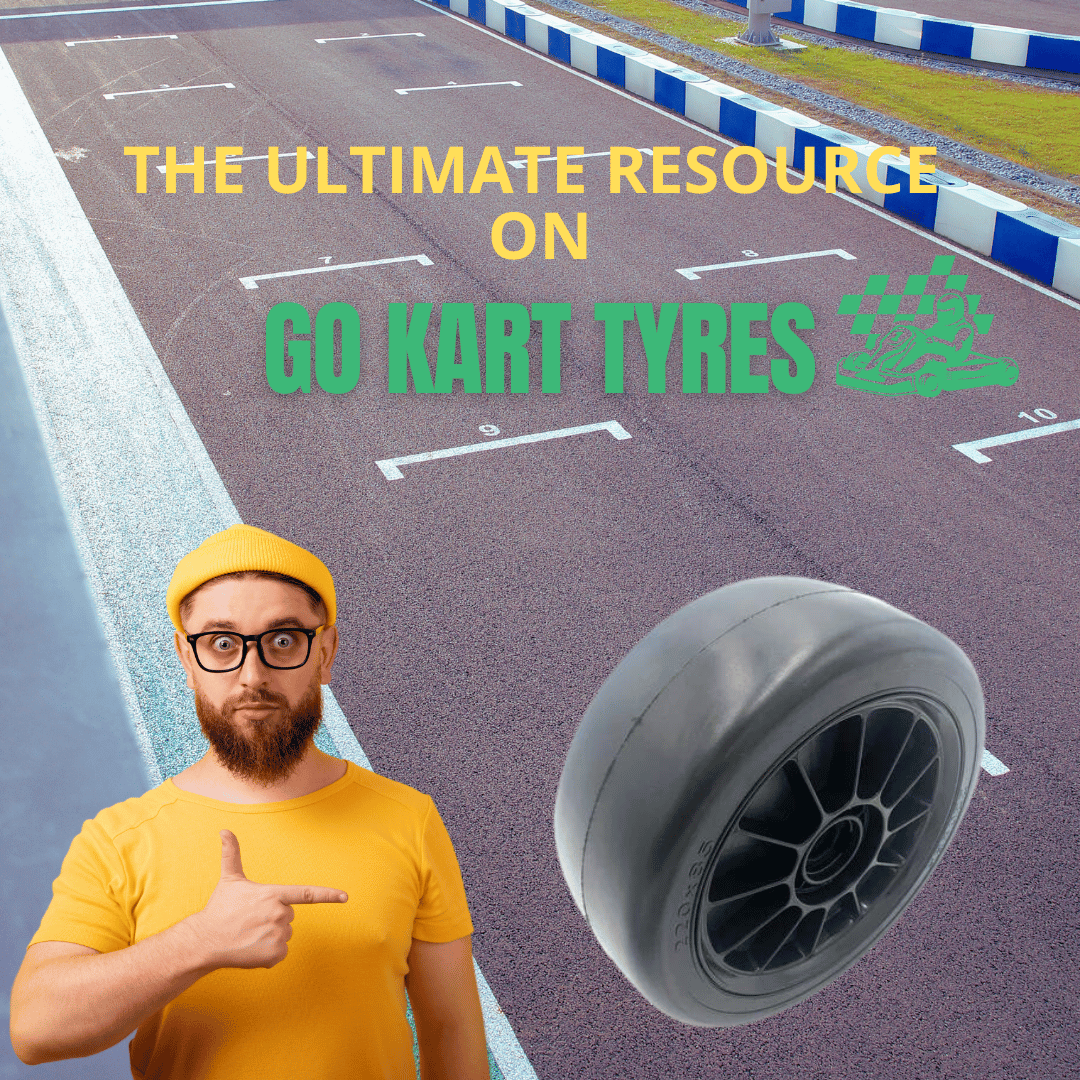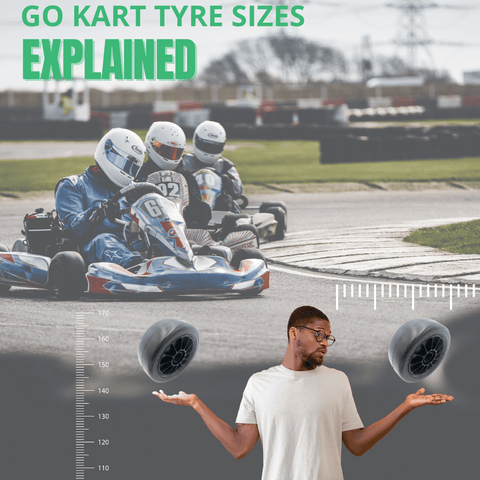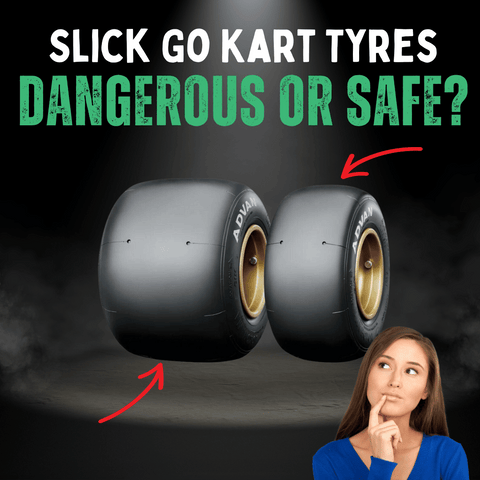
Updated: 16.05.25
Feel the thrill of go-karting as your tyres grip the track, powering you through twists and turns? Whether it’s a kids’ ride-on go-kart or a competitive racer, tyres are the key to speed, control, and safety. This 2025 guide dives into go-kart tyre types, sizes, compounds, costs, and maintenance, helping parents and enthusiasts choose the best tyres for any track. Download our free go-kart tyre maintenance checklist to keep your kart race-ready!
1. Types of Go-Kart Tyres
Go-kart tyres are designed for specific track conditions, from smooth asphalt to muddy off-road trails. Here’s a breakdown of the main types, including their features and best uses.
1.1 Slick Tyres
Slick tyres are the go-to for dry tracks, offering maximum grip and speed for kids’ go-karts and competitive racers. Their smooth tread maximizes contact with the track, ideal for cornering.
- Compounds: Soft (high grip, fast wear), medium (balanced), hard (durable, less grip).
- Standards: CIK-FIA homologated for professional racing, ensuring safety and performance.
- Material: Blend of natural/synthetic rubber, carbon black, and oils for grip and durability.
Discover why slick tyres offer superior grip on dry tracks.
Best for: Dry asphalt tracks, high-speed cornering.
Related: Slick Go-Kart Tyres: Dangerous or Safe?
1.2 Wet Tyres
Wet tyres shine on damp or rainy tracks, with grooved treads to displace water and prevent hydroplaning. They’re versatile for unpredictable weather, balancing grip and durability.
- Grip: Moderate traction for slippery surfaces.
- Rolling Resistance: Balanced for speed and longevity.
- Durability: Outlasts soft tyres, performs on damp and dry tracks.
- Material: Synthetic rubber, carbon black, oils for wet traction.
Learn how to drive a go-kart safely in wet conditions.
Best for: Wet or mixed track conditions.
Related: Are All Go-Karts Rear-Wheel Drive?
1.3 Oval Tyres
Oval tyres are tailored for continuous turns on oval tracks, offering stability and grip for asphalt or dirt surfaces, common in U.S. karting.
- Wide Profile: Increased contact area for better grip.
- Stiff Sidewalls: Handle constant turning stress.
- Non-Homologated: Often used in non-CIK-FIA events.
- Material: Natural/synthetic rubber, carbon black, oils.
Best for: Oval tracks, both asphalt and dirt.
Related: Are Slick Go-Kart Tyres Faster?
1.4 Dirt/Off-Road Tyres
Dirt/off-road tyres tackle rugged terrains like gravel, mud, or grass, with knobby treads for traction and robust builds for durability.
Watch off-road go-kart tyres conquer dirt tracks.
- Knobby Tread: Grips loose surfaces like dirt or mud.
- Reinforced Sidewalls: Resist punctures from rocks or debris.
- Wide Stance: Enhances stability on uneven terrain.
- Material: Durable rubber compounds with additives for toughness.
Best for: Off-road tracks, muddy or gravelly conditions.
1.5 Concession Tyres
Concession tyres are durable, all-purpose tyres used in rental karts, designed for heavy use across various conditions.
- Durable Compound: Resists wear from frequent use.
- Uniform Size: Fits most rental karts for easy replacement.
- Versatile: Performs on dry and slightly wet tracks.
- Cost-Effective: Budget-friendly for rental businesses.
- Material: Synthetic rubber, carbon black, oils, durability additives.
Best for: Rental karts, mixed track conditions.
| Tyre Type | Key Features | Best For |
|---|---|---|
| Slick | Smooth tread, soft/medium/hard compounds, CIK-FIA homologated | Dry asphalt tracks |
| Wet | Grooved tread, balanced grip/durability, synthetic rubber | Wet or mixed tracks |
| Oval | Wide profile, stiff sidewalls, non-homologated | Oval tracks (asphalt/dirt) |
| Dirt/Off-Road | Knobby tread, reinforced sidewalls, durable compounds | Off-road, muddy/gravel tracks |
| Concession | Durable, uniform size, versatile for mixed conditions | Rental karts, diverse tracks |
2. Tyre Sizes and Compatibility
Learn how to choose the right go-kart tyre sizes.
Tyre size impacts speed, handling, and safety. Incorrect sizes can reduce performance or damage the kart, especially for kids’ models.
Choosing the Right Size
- Check Manual: Refer to your go-kart’s manual for recommended sizes (e.g., 10x4.50-5 for front, 11x7.10-5 for rear on kids’ karts).
- Track Conditions: Smaller tyres suit tight tracks; larger ones improve stability on open circuits.
- Compatibility: Ensure tyres match wheel rim diameter and kart frame.
Understand go-kart tyre sizes for optimal performance.
Related: Do Go-Kart Tyres Have Tubes?
3. Tyre Compounds Explained
Tyre compounds (soft, medium, hard) determine grip, durability, and rolling resistance, tailored to track conditions and racing style.
3.1 Soft Compounds
Soft tyres maximize grip for short, high-intensity races but wear quickly.
Best for: Smooth tracks, sprint races, maximum cornering speed.
3.2 Medium Compounds
Medium tyres balance grip and durability, ideal for mixed conditions or longer races.
Best for: Versatile tracks, recreational karting.
3.3 Hard Compounds
Hard tyres prioritize longevity and low rolling resistance, sacrificing some grip.
Best for: Rough tracks, endurance races.
3.4 Tubed vs. Tubeless Tyres
- Tubed: Inner tube holds air, cheaper (£20–£50 per tyre), durable for rough tracks, higher rotational inertia. Common in kids’ rental karts.
- Tubeless: Airtight seal with wheel, lighter, lower inertia, puncture-resistant, better handling (£30–£80 per tyre). Preferred for competitive karting.
Choose based on budget, track type, and kart model. See our tyre pressure guide.
4. Go-Kart Tyre Costs
Tyre costs vary by type, compound, brand, and purchase source, impacting budget for parents and racers.
Cost Breakdown
- Slick/Wet Tyres: £30–£100 per tyre; £120–£400 for a set of four.
- Dirt/Off-Road Tyres: £40–£120 per tyre; £160–£480 per set.
- Concession Tyres: £20–£60 per tyre; £80–£240 per set (rental karts).
- Used Tyres: £10–£40 per tyre; £40–£150 per set (e.g., eBay), but check wear.
Factors Affecting Cost
- Brand: Premium brands (e.g., LeCont, Hoosier) cost more than budget options (e.g., UNILLI).
- Compound/Size: Soft compounds and larger sizes increase costs.
- Purchase Source: Online retailers (e.g., Amazon) may offer deals vs. local shops.
Balance cost with performance; cheap tyres may compromise safety. Shop our go-karts for budget-friendly options.
5. Finding Go-Kart Tyres Near You
Search “go-kart tyres near me” on Google or Yelp to find local suppliers or karting tracks offering tyres. Check RiiRoo’s UK karting locations guide for nearby retailers. Online options like eBay or Amazon provide convenience, but verify compatibility.
6. Tyre Maintenance and Wear
Proper maintenance extends tyre life and ensures safety, especially for kids’ go-karts.
Signs of Wear
- Cracks, cuts, or bald spots
- Uneven tread wear (indicates alignment issues)
- Reduced grip or sliding in corners
Maintenance Tips
- Check Pressure: Maintain 15–25 PSI (check manual) before each session. See our over-inflation guide.
- Inspect Regularly: Look for damage weekly; rotate tyres to even wear.
- Store Properly: Keep in a cool, dry place away from sunlight.
- Clean Tyres: Remove debris after races to prevent wear.
Download our free checklist to track maintenance.
7. Weather and Tyre Performance
Weather affects tyre grip, pressure, and wear, impacting safety and performance.
- Heat: High temperatures increase pressure (e.g., +2–5 PSI), accelerating wear; check pressure frequently.
- Cold: Low temperatures reduce pressure, causing underinflation; inflate to spec.
- Wet Conditions: Wet tyres prevent hydroplaning; adjust driving for reduced traction.
Related: How to Drive a Go-Kart in the Wet
8. Choosing the Best Go-Kart Tyre Brands
Top brands offer quality and performance, but vary by price and track suitability.
Popular Brands
- LeCont: High-grip slicks/wet tyres, CIK-FIA homologated (£50–£100).
- Hoosier: Durable oval/dirt tyres, popular in U.S. (£40–£90).
- UNILLI: Budget-friendly concession tyres (£20–£60).
- Goodtime Rubber: Versatile off-road tyres (£30–£80).
Choosing a Brand
- Track Type: LeCont for asphalt; Hoosier for dirt/oval.
- Budget: UNILLI for cost-saving; LeCont for premium performance.
- Regulations: Ensure tyres meet racing series rules (e.g., CIK-FIA).
9. Tyre Preparation for Racing
Tyre prep formulas enhance grip but must be used carefully and per regulations.
How to Apply Tyre Prep
- Clean tyres with soap and water; dry completely.
- Apply prep formula (e.g., mineral spirits-based) with a brush or spray.
- Let soak for 10–30 minutes (per manufacturer instructions).
- Wipe off excess with a clean cloth.
- Ensure tyres are dry before racing.
Note: Check racing rules, as some series ban prep formulas.
10. Conclusion
Go-kart tyres are more than rubber—they’re the key to speed, safety, and fun, whether for kids’ ride-on go-karts or competitive racers. From slick tyres for dry tracks to knobby off-road options, choosing the right type, size, and compound transforms your karting experience. Use our free maintenance checklist to keep tyres in top shape. Ready to race? Explore RiiRoo’s kids’ go-karts for thrilling family adventures!
Are slick go-kart tyres safe for racing?
Frequently Asked Questions
How do I extend the lifespan of go-kart tyres?
Inspect weekly for damage, maintain 15–25 PSI pressure, store in a cool/dry place, and use track-appropriate tyres. Download our checklist for tips.
What’s the right tyre size for my go-kart?
Check your kart’s manual (e.g., 10x4.50-5 front, 11x7.10-5 rear for kids’ karts). Consult RiiRoo or a karting expert for compatibility.
Which tyres are best for wet tracks?
Wet tyres with grooved treads prevent hydroplaning and maintain grip in rain. See our wet driving guide.
What do go-kart tyre numbers mean?
Numbers indicate rim diameter, tyre width, and sidewall height (e.g., 11x7.10-5: 11” rim, 7.10” wide, 5” sidewall).
Should I warm up go-kart tyres?
Yes, warming tyres via slow laps or tyre warmers boosts grip. See our tyre warming guide.
How much do go-kart tyres cost?
Slick/wet tyres cost £30–£100 each (£120–£400 per set); dirt tyres £40–£120 (£160–£480); concession tyres £20–£60 (£80–£240). Used tyres range £40–£150 per set.
Additional Resources
- Best Go-Kart Gear Ratios
- Balancing Go-Kart Tyres
- Slick Tyres Grip Guide
- Go-Kart Tyre Sizes Explained
- Tubed vs. Tubeless Tyres
- Kids’ Go-Karts
Get in Touch 🚀
Loved our guide to go-kart tyres? Ready to race with your kids?
Parents, we’re here for all your go-kart questions—tyre compounds, pressures, or track tips! 🏎️
Visit RiiRoo.com, use our Live Chat, or email hello@riiroo.com to explore our kids’ go-karts!









Share:
Comparing Eva Tyres vs Rubber Tyres: Pros, Cons, and Performance
Go Kart Tyre Durability: How Long Can You Expect Them to Last?